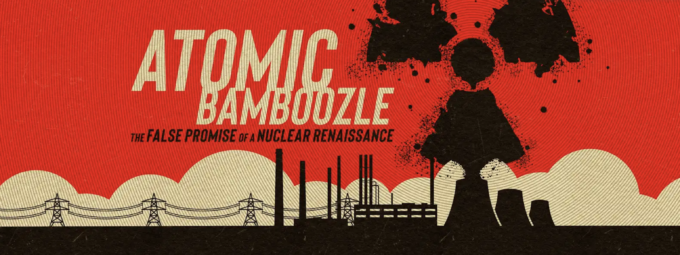Don’t Be Bamboozled by Nuclear Power

In the face of a complex and urgent problem like climate change, it’s tempting to believe in simple solutions. Just as detox teas or diet pills claim to solve health issues that truly require lifestyle changes, nuclear energy has been marketed as a quick fix for the socio-political problem that climate change is. It’s presented as an essential part of the climate solution, yet, like many health fads, it is both ineffective and harmful. Today, nuclear energy is being pushed in the form of Small Modular Reactors (SMRs)—touted as the latest technological miracle.
Jan Haaken’s latest documentary, Atomic Bamboozle, pulls back the curtain on this techno-fantasy, revealing SMRs for what they truly are: old wine in a new bottle. Haaken, a seasoned filmmaker who has tackled climate action in her recent Necessity films, unravels the fantastic narrative surrounding SMR propaganda through humor, expert testimony, and a rich history of grassroots resistance.
Haaken intersperses the industry’s lofty claims with a systematic critique from nuclear expert M. V. Ramana, who debunks the promises of SMRs. Despite their high-tech veneer, these reactors are burdened by the same issues that have long plagued the nuclear industry: exorbitant costs, proliferation risks, risk of catastrophic accidents, and the unresolved nightmare of nuclear waste. The arguments presented concisely here are expanded upon in Ramana’s recent book, Nuclear is Not the Solution: The Folly of Atomic Power in the Age of Climate Change, which offers a comprehensive critique, demonstrating that nuclear energy is neither a desirable nor feasible solution to the climate crisis.
Haaken then draws our attention to the troubled legacy of nuclear power through the resistance to the Trojan Nuclear Power Plant and the ongoing pollution at the Hanford Site. Voices like Lloyd Marbet, a key figure in the Trojan resistance, highlight the dangers inherent in nuclear projects and the struggle to hold industry accountable. Marbet recalls the safety issues surrounding Trojan, such as cracks in its steam generators and the mounting costs required to address them—which eventually led to its shutdown. Meanwhile, First Nations advocates like Cathy Sampson-Kruse and Dr. Russell Jim emphasize the environmental devastation caused by the Hanford Site. The Yakama Nation, along with other activists, have been fighting tirelessly to protect their land and the Columbia River from contamination, underscoring the toxic legacy that still requires cleanup decades later.
Haaken expertly contrasts these real-world examples of nuclear disasters with the glossy, futuristic promises of SMRs as a “clean, green” energy source. This juxtaposition slices through the propaganda and traces the roots of the narrative back to the “Atoms for Peace” program. After the devastation of Hiroshima and Nagasaki, this initiative sought to rebrand nuclear technology as a “friend” to humanity – presenting nuclear power as a powerful genie that could be safely contained within the walls of a reactor. However, the nuclear industry’s legacy of pollution, which will take thousands of years to clean up, and catastrophic accidents like Fukushima demonstrate that this reassuring image is far from reality.
One of the most dangerous effects of technological quick fixes is their ability to obscure the power dynamics underlying climate issues. Big corporations and influential individuals hide behind technological solutions, deflecting attention from the required changes to a system that disproportionately benefits them. Haaken, therefore, makes a point to focus on billionaires like Bill Gates, who are promoting SMRs. In the video clip shown in the documentary Gates awkwardly plays down the issue of nuclear safety, while Ramana reveals a deeper irony: despite Gates’ immense wealth, even he relies on public funding to push forward these risky projects. Investors seem reluctant to gamble their own money on unproven technologies like SMRs, raising serious doubts about their viability.
This brings Haaken’s sharp yet accessible critique of nuclear energy to its full conclusion, succinctly captured in the film’s title—Atomic Bamboozle. The title itself exposes the latest SMR trend for what it truly is: a sales trick designed to siphon off your tax dollars, peddling an overpriced technology through confusing jargon and false promises.
The Sierra Club Grassroots Network Nuclear Free Team is concluding its first Nuclear-free Film Series with the powerful independent film, ATOMIC BAMBOOZLE: THE FALSE PROMISE OF A NUCLEAR RENAISSANCE. As political pressure mounts in the US to meet net zero carbon goals, the nuclear power industry makes its case for a nuclear “renaissance.” This documentary by NECESSITY Director Jan Haaken follows activists as they expose the true costs of the new small nuclear reactor designs.
No comments:
Post a Comment